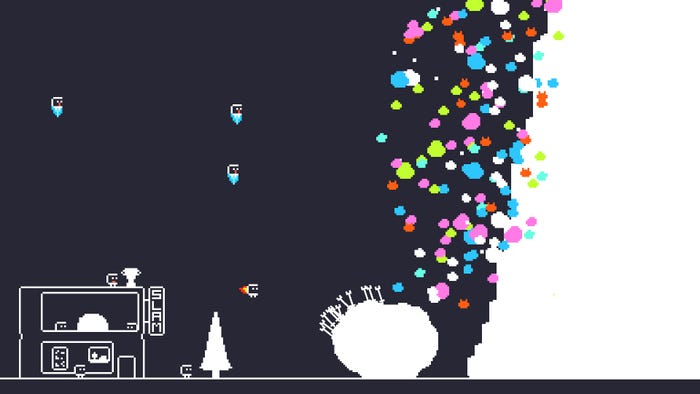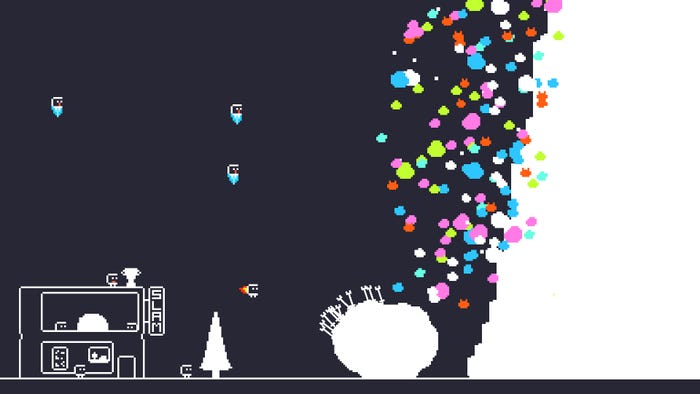
(the) Gnorp Apologue sees players guiding little critters into finding steadily smarter, more effective ways to bash a rock for endless colorful profits.
Game Developer sat down with Myco, the game’s creator, to talk about the appeal of having so many small gnorp creatures flying around the screen and how it added to the enjoyment of watching big numbers go up, the ideas that went into adding expression into the simplistic design of the gnorps, and the thought process behind the game’s multiplier system that would lead to massive, colorful wealth.
(the) Gnorp Apologue is about little critters hitting a rock in order to get massively wealthy. What inspired the creation of such an experience?
The game was based on a tiny little incremental game I made for my girlfriend, now wife. I then chose to further develop the concept when learning a new programming language, and as the game grew I decided to make a full game out of it.
I really like the idea of an incremental game, and what I wanted to do with (the) Gnorp Apologue was to create a more visual incremental game that was still an incremental game. There are many games that can be considered an abstracted incremental game, like Diablo or Vampire Survivors, but those game typically feature controlling a character, and I felt that that, in some regard, stands in the way of the enjoyment players derive from watching numbers grow.
In the end, I do think I succeeded, and I am excited to continue with my ideas going into Gnorps In Space.
When the gameplay goal is arguably just to make numbers go up very high, what thoughts go into making an interesting game around that concept? How did the game build out from that idea of making rising numbers as appealing as possible?
The core pillars of the (the) Gnorp Apologue are the rock, the pile, and how the gnorps interact with the rock, pile and each other.
Incremental games do typically allow you to buy different units that provide some form of currency, and those units are typically represented as a number. In (the) Gnorp Apologue, what I really wanted to do was to show those units and have them individually simulated.
If you have 2,000 gnorps hitting a rock and 20,000 shards flying in the air, that should all be shown on screen. Typically, games hit the breaks before things get excessive, but I wanted excessive to properly represent the nature of an incremental game. With individually simulated units, it allows you to create interesting upgrades beyond a simple percentage increase to their output.
In (the) Gnorp Apologue, it is all about the gameplay and simple visuals that become more than the sum of their parts thanks to the ridiculous number of things being drawn on screen at once.

Images via Myco.
The game features a minimalistic art style that is still really exciting and colorful. What thoughts went into creating the game’s visual style?
I chose a minimalist art style, as that was something I felt I could pull off, and I picked a mostly monochromatic color scheme so that players would feel they were bringing color into the world as they progressed in the game. Ultimately, the art could be considered programmer art that strove to take it up a notch.
What thoughts went into the design of the gnorps themselves? How did you design the small creatures to be adorable and expressive, even in simplicity?
For me, one of the most appealing parts about pixel art is that every single pixel matters. A single misplaced pixel can cause the art to look off, and likewise, a single well-placed pixel can really make the art pop. Their expressiveness was discovered through experimentation, and I found it immensely satisfying to communicate their emotions effectively through just a few pixels.
The human brain is really effective at reading between the lines, and an example of that is the legs of gnorps are not animated. The players see the gnorps have legs and interpolate the logic of the locomotion from that. I attempted to animate the legs, but it looked horrific and I quickly deleted the code.
Likewise, what thoughts went into designing the various things the gnorps could do? How did you design all of the myriad ways they could collect the shards? Why did you design them this way?
The methods of collection and damage had to be different; that was the most important thing for me. While I didn’t do a perfect job of providing each damage and collection source with a perfect niche, I am happy where it ended up.
For damage, I differentiated through statuses, asymmetrical scaling, and range profiles. For collection, I differentiated primarily through asymmetrical scaling.
As the development process went on, the process of creating new and interesting ways to deal damage and collect shards grew increasingly harder. It was both difficult to come up with non-bloating, compelling visual design for new units, as well as something new gameplay-wise.
Getting shards from a rock sounds like an incredibly simple gameplay goal, but you have added many different gameplay elements to give players tons of depth in how they get their shard wealth. Can you tell us a bit about how you designed the gnorp upgrade system to that end of giving players a complex means of meeting their goal?
One of the fun parts about art is working within certain constraints. The core idea is certainly simple, and that was sort of the point. Making that interesting was hard, yes, but at the same time that sort of constraint pushed the boundaries of my creativity and forced me to think things through.
The core idea was the rock + gnorps, and slammers and runners quickly sprang from that. From there, I felt it important to give each new unit a niche and a personality, and that also informed how upgrades work—they should be unique, and they should be interesting.
My blueprint for a good upgrade, was this:
– Changes the behavior of the gnorp it upgrades
– Not mandatory
– Works in tandem with talents to enable something new
Talents were designed in a similar manner, and the intent of every talent was this:
– Enables something new gameplay-wise
– Does something new
That meant that an ideal talent would both offer up a nice bonus and, at the same time, allow you to create an interesting combination with another talent or upgrade. I didn’t hit that mark on all talents, but that consistency of design is something that I will continue striving for in all my projects, including the future of (the) Gnorp Apologue.
You have also designed many structures for (the) Gnorp Apologue. What ideas went into designing these structures to give players more options to collect shards?
Initially, the only structures you would build were the housing. The game featured a pretty regular user interface that sat on top of the game screen, and you would acquire new units by interacting with that UI. When I made more units and saw how it would bloat the UI with more and more gnorps and upgrades, I saw an opportunity to have buildings that would be host to the different gnorps and their respective upgrades, and the UI to buy and upgrade would be accessed through the building itself.
I tried to feature a diverse range of buildings, and there were a few left on the cutting room floor that I chose not to implement simply because there would be too many.
What thoughts went into making all of these systems intertwine? How do you create systems and interesting abilities so that players can create fun synergies for themselves? How do you design these systems so that players keep pushing to see what neat ways they can make those shard numbers shoot up?
What is interesting to a player is something that you can write a whole book about, but what it boiled down to, for me, was that I had to think about the problem long enough. Good ideas do not come cheap. Typically, I would start with a nugget of thought that potentially developed into something that I would consider interesting. From there, I massaged further until I either discarded it or was left with a good idea.
An example of this is the multiplier. How does it grow, I asked myself, and I had a few answers:
– First implementation was that the multiplier would grow with every upgrade bought. The problem with this one was that it would incentivize the player to buy every single upgrade, even if they did not need it.
– The second idea I thought was good was that the multiplier would grow based on the total number of shards spent. This one was problematic because it also incentivized buying every single upgrade, but more importantly, the multiplier could suddenly grow significantly because the player spent a large number of shards and thus the multiplier would also grow a large amount. That felt a bit odd.
– I finally found a good idea, and that was simply to tie the multiplier to the number of gnorps spent. It was simple, predictable, and avoided the problems of all the other solutions. Gnorps are the heart of the game, and it made sense that they would all grow stronger as their numbers grew.
I think games are interesting when they feature several layers of gameplay mechanics that interact with each other, and I find it disappointing when those individual layers are too complicated or non-existent. A good middle-ground is what I hope I achieved in (the) Gnorp Apologue: Approachable layers where the complexity is derived from the interaction between the layers.
Have the players created anything surprising out of your systems? Can you tell us about some of the wild creations the players have made? Any synergies they have put together that you may not have expected?
It was extremely fun to hear about players discovering cool synergies, but as far as I can tell I was able to account for all of them!
Some systems have been abused to reach unexpected numbers of talent points, and I did not expect the level of patience required to pull it off. Huge shoutout to Nobody on Discord for providing great feedback, and for getting up to all sorts of wild stuff with the game, including reaching a staggering 31 talent points through the aforementioned abuse.






